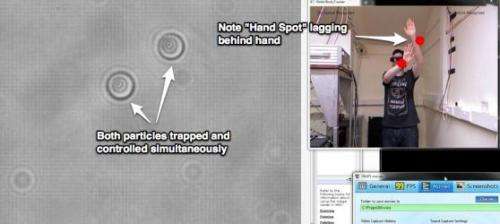November 5, 2012 report
Physicists use Kinect to control holographic tweezers (w/ Video)

(Phys.org)—Researchers at the University of Dundee in Scotland have devised a means of using a Microsoft Kinect sensing system to allow for hand control of holographic optical tweezers. They describe their results in a paper they've uploaded to the preprint server arXiv.
Laser tweezers are laser based devices that allow for manipulation of very small objects; typically at the cellular level. A laser beam is projected towards a target, but before reaching it, is split into three separate beams. The three beams are broadcast onto the edges of the object to be manipulated – as the beams are moved the object is caused to move in lockstep. Thus far, however, fine tuning control of the laser to cause the movement of an object has been less than ideal, causing researchers to continue looking for alternative means. In this new research, the team connected a Microsoft Kinect device to the tweezers and then demonstrated an ability to move microscopic sized objects by moving their hands around in the air.
The Kinect device employs a camera, an infrared laser and a microchip to make sense of what the camera and laser detect in three dimensional space. Its original purpose was to serve as a video game input device, but researchers have put it to use in many other applications. In this instance, by connecting a Kinect device to their virtual tweezers, the researchers found that they were able to define the space in which they wished to work by using simple hand movements and then to connect, virtually to a particular tiny object; in this case a silicon microsphere, and then to cause it to move, by making corresponding moves with their hand.
The Kinect device is not precise enough to capture subtle movements however, is error prone and doesn't allow for force-feedback, or the ability to feel the resistance of an object as its being moved, thus the resultant system, which the team calls HoloHands, is not sophisticated enough to allow for serious research work. Instead, they envision it being used as a tool for educational purposes, either as a tool, or implemented as a learning game.
More information: HoloHands: Kinect Control of Optical Tweezers, arXiv:1211.0220 [physics.pop-ph] arxiv.org/abs/1211.0220
Abstract
The increasing number of applications for holographic manipulation techniques has sparked the development of more accessible control interfaces. Here, we describe a holographic optical tweezers experiment that is controlled by gestures which are detected by a Microsoft Kinect. We demonstrate that this technique can be used to calibrate the tweezers using the Stokes Drag method and compare this to automated calibrations. We also show that multiple particle manipulation can be handled. This is a promising new line of research for gesture-based control that could find applications in a wide variety of experimental situations.
via TechReview
Journal information: arXiv
© 2012 Phys.org




















